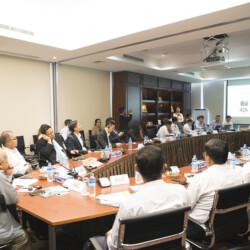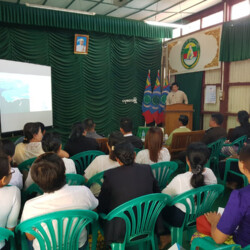M&AOSB Completes EIA for Proposed Offshore Supply Base.
Kyisin H. Aung
Myint & Associates Offshore Supply Base Ltd. (M&AOSB) has completed an Environmental Impact Assessment (EIA) of the proposed offshore supply base near Nga Yoke Kaung bay and submitted findings to the Environmental Conservation Department (ECD) of the Ministry of Natural Resources and Environmental Conservation (MONREC) for review. The EIA report details anticipated risks, impacts, and mitigation measures against potential negative impacts from proposed development activities.
Why do we need EIAs?
EIA is a tool to systematically safeguard the environment and people potentially affected by proposed development activities. It is important for M&AOSB to identify potential risks and impacts associated with the project early in order to effectively mitigate and protect the environment and the surrounding communities. A key element of an EIA is public participation. Firmly believing that EIAs should not be treated as necessary evil, M&AOSB has openly and repeatedly engaged local communities to capture concerns and feedback during the design phase of the project. We are fully conscious of the local and environmental and cultural beauty of the area and intend to develop the supply base in a manner that has a minimal impact on the environment and lead to enhancement of the lives of the local communities.
How is it done?
The Environmental Impact Assessment Procedures (2015) prescribes strict standards for carrying out the EIA. We appointed a third party organization to identify, predict, and mitigate the biophysical and social effects of the proposed development. Going above and beyond the EIA requirements for two public consultations, we have communicated to stakeholders project progress on an ongoing basis and at key milestones, such as when we received approval from the Myanmar Investment Commission. We have also captured concerns and feedback through the M&AOSB Operational Grievance Mechanism (OGM), which is designed to respond to community complaints. Through repeated consultative process and listening to our stakeholders, we learned that community members were rightly concerned about, to name a few, environmental pollution, impact on livelihoods, and impact on their freedom of movement. They also had positive expectations that the proposed project would create jobs and bring social investments to the project area. We have also learned of community concerns and feedback through our community-based volunteers. We believe that it is important to educate members of the local community whom the majority of the community trusts to communicate progress. We believe that it is good business to responsibly manage environment and social effects from our operations and, hence, have committed to managing them effectively in the proposed Environmental Management Plan (EMP) and Social Management Plan (SMP).
What’s next?
We are now in the disclosure phase and have submitted assessment findings to the government and public for comments. Comments from these stakeholder groups will be taken into account to finalize the mitigation measures and obtain an Environmental Compliance Certificate. We do not believe that receiving regulatory approval is the end of the road. It is just the beginning as we will strictly adhere to environmental and social management systems to protect the environment and people as long as the supply base is in operation.








